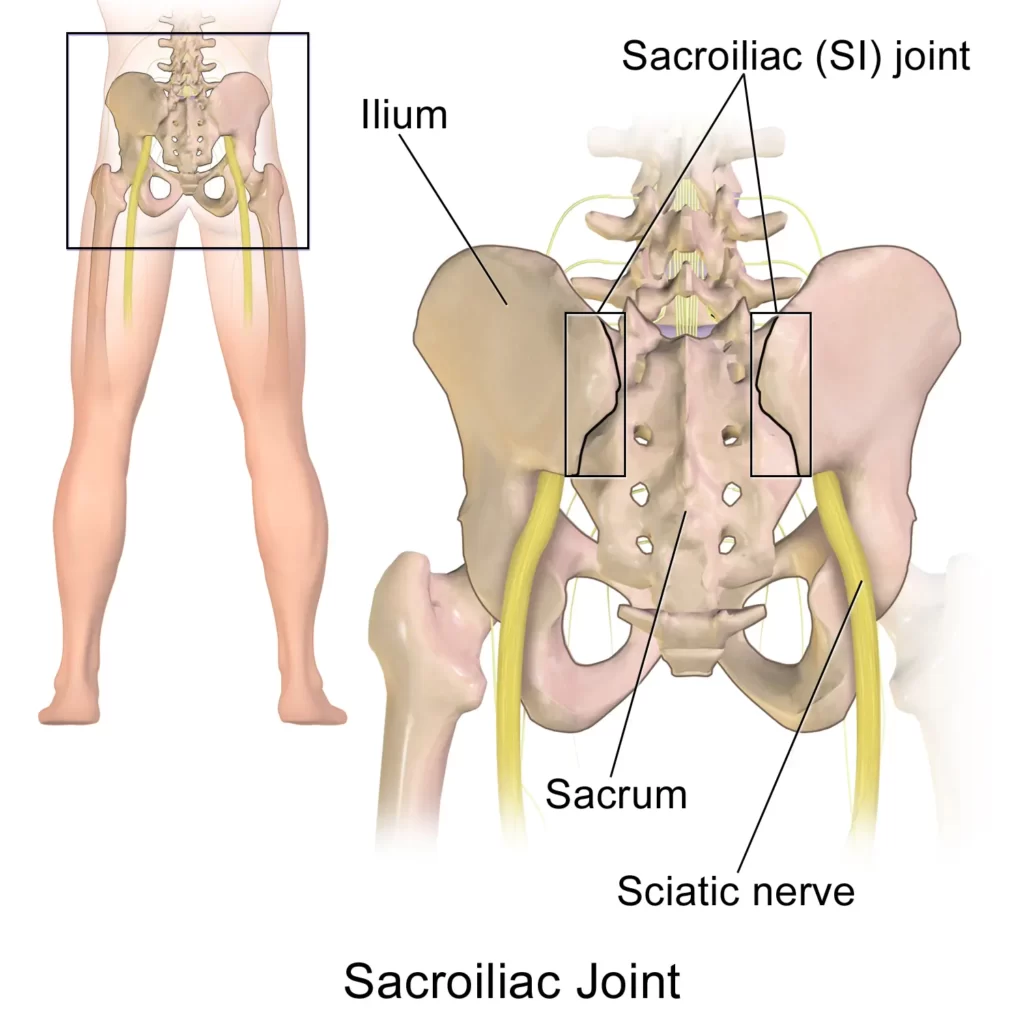
Pregnancy is a beautiful and life-changing experience for women, but it can also come with its fair share of discomforts. One of the most common discomforts experienced by pregnant women is sacroiliac joint pain. The sacroiliac joint is located in the pelvis and connects the sacrum to the ilium bones. During pregnancy, the sacroiliac joint can become inflamed due to increased mobility caused by the release of hormones. This article on PregnancyBoss aims to provide a comprehensive guide to sacroiliac joint pain during pregnancy, including its causes, symptoms, diagnosis, treatment options, and prevention and self-care tips.
Where Are The SI joints?

The sacroiliac (SI) joints are located in the pelvis and connect the outer side of the spine’s sacrum to the inner side of the hip bone. They are situated deep in the pelvis and are the lowest part of the tailbone that links the sacrum to the iliac bone. The SI joint is a synovial joint filled with fluid, and the joint surfaces are lined by different types of cartilage. The SI joint has very limited motion ranging from 2 mm to 4 mm and 2° to 5°, and it is secured and well-protected by strong ligaments.
Causes and Risk Factors of Sacroiliac Joint Pain During Pregnancy
Sacroiliac joint pain during pregnancy is caused by the release of hormones that relax the ligaments in the pelvic area. This relaxation allows the pelvis to expand during childbirth, but it can also cause instability in the sacroiliac joint, leading to pain and discomfort.
Other risk factors that can contribute to sacroiliac joint pain during pregnancy include:
- Previous lower back or pelvic injuries
- Poor posture
- Excessive weight gain during pregnancy
- Repetitive stress on the sacroiliac joint
Symptoms and Diagnosis of Sacroiliac Joint Pain During Pregnancy
The symptoms of sacroiliac joint pain during pregnancy can vary from person to person, but common symptoms include:
- Pain in the lower back, hips, groin, and thighs
- Pain that worsens when standing or walking
- Pain that improves when lying down
- Stiffness in the lower back and hips
- Difficulty standing up from a sitting position
If you are experiencing any of these symptoms, it is important to consult your healthcare provider for a proper diagnosis. Your healthcare provider may perform a physical exam, review your medical history, and order imaging tests such as X-rays or an MRI to rule out other conditions that may be causing your symptoms.
Treatment Options for Sacroiliac Joint Pain During Pregnancy

There are several treatment options available for sacroiliac joint pain during pregnancy, including:
- Physical therapy: A physical therapist can help you strengthen the muscles around the sacroiliac joint, improve your posture, and reduce pain through exercises and stretches.
- Chiropractic care: A chiropractor can perform adjustments to the sacroiliac joint to improve its alignment and reduce pain.
- Medications: Over-the-counter pain relievers such as acetaminophen can be used to manage pain. However, it is important to consult with your healthcare provider before taking any medication during pregnancy.
- Support belts: A support belt can be worn around the hips and lower back to provide additional support to the sacroiliac joint.
- Acupuncture: Acupuncture can be used to reduce pain and improve mobility in the sacroiliac joint.
Prevention and Self-Care Tips for Sacroiliac Joint Pain During Pregnancy

While it may not be possible to prevent sacroiliac joint pain during pregnancy, there are several self-care tips that can help alleviate symptoms, including:
- Maintaining good posture: Avoid slouching and try to sit and stand up straight to reduce stress on the sacroiliac joint.
- Sleeping on your side: Sleeping on your side with a pillow between your knees can help reduce pressure on the sacroiliac joint.
- Applying heat or cold: Applying heat or cold to the lower back and pelvis can help reduce inflammation and alleviate pain.
- Engaging in low-impact exercise: Exercise such as walking, swimming, and prenatal yoga can help strengthen the muscles around the sacroiliac joint and improve flexibility.
- Avoiding high-impact activities: Activities such as running and jumping can put stress on the sacroiliac joint and worsen symptoms.
Conclusion
In conclusion, sacroiliac joint pain during pregnancy is a common discomfort, but with the right care and treatment, you can manage it effectively and enjoy this beautiful journey to motherhood. Remember to consult with your healthcare provider to create a personalized plan that suits your unique needs. Your comfort and well-being during pregnancy are of utmost importance.
Frequently Asked Questions (FAQs)
Is sacroiliac joint pain during pregnancy common?
Yes, sacroiliac joint pain is a common discomfort experienced by pregnant women. It is estimated that up to 25% of low back pain during pregnancy is caused by sacroiliac joint dysfunction.
When does sacroiliac joint pain during pregnancy typically start?
Sacroiliac joint pain during pregnancy typically starts in the second trimester, around the 18th week of pregnancy.
Can sacroiliac joint pain during pregnancy be prevented?
While it may not be possible to prevent sacroiliac joint pain during pregnancy, there are several self-care tips that can help alleviate symptoms. Maintaining good posture, sleeping on your side, applying heat or cold, engaging in low-impact exercise, and avoiding high-impact activities can all help reduce stress on the sacroiliac joint.
Is it safe to take medication for sacroiliac joint pain during pregnancy?
It is important to consult with your healthcare provider before taking any medication during pregnancy, including over-the-counter pain relievers such as acetaminophen.
Can physical therapy help with sacroiliac joint pain during pregnancy?
Yes, physical therapy can be an effective treatment option for sacroiliac joint pain during pregnancy. A physical therapist can help you strengthen the muscles around the sacroiliac joint, improve your posture, and reduce pain through exercises and stretches.






